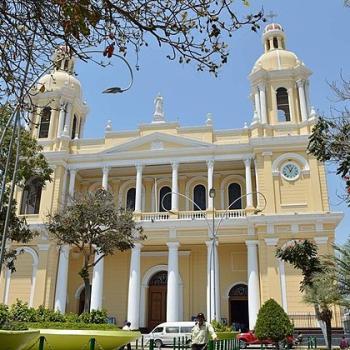Lectionary Reflections for July 17, 2011
Matthew 13: 24-30, 36-43
I am a great fan of mystery fiction. I never seem to tire of detective novels, TV shows and movies. I enjoy the process of gathering clues and coming to conclusions. It's so satisfying to guess who did it before the final page or act. Sherlock Holmes is one of my heroes. It came as a great disappointment to me to find, when I visited London years ago, that 221B Baker Street is a museum to a fictitious detective, not the home of a real historical person.
The Bible, on the other hand, is not a museum filled with fictional characters, but a library of mysteries involving real live people, awaiting our investigation. Interpreting the Bible calls for shrewd detective work. We can rarely pinpoint exactly "whodunnit" with regard to the authorship of books and portions of books. When we interview each of the four evangelists, for example, spaces remain blank next to Name, Birthdate, Address, and "Where were you on the night of...?" We don't know exactly who wrote Matthew. The material in Matthew doesn't seem to come from an eyewitness to Jesus' ministry, so the author was probably not Matthew the tax collector, one of the disciples of Jesus (Mt. 9:9). The Gospel of Matthew was probably written by a Jewish Christian living in about A.D. 85-90 in the Syrian town of Antioch, the city from which Paul and Barnabas were sent as missionaries (Acts 13-14).
We may not know the name and addresses of each of the four evangelists, but we do know that each of them wrote their gospel to a particular group of people for a particular purpose. As biblical detectives, we put their themes and theology under a magnifying glass and ask this question: In what context would these themes and theology be crucial communication? A way to get at this is to imagine the text as someone's attempt to answer a question and then try to figure out what that question might be. Often, a text addresses more than one question.
Let's look at the parable of the weeds and the wheat and gather some clues as to what question(s) it is meant to answer in its context.
The first clue is that it is only found in Matthew's gospel. This leads me to suspect that Matthew shaped this parable to address some situation regarding two groups of people in his congregation.
The second clue is that Matthew's gospel as a whole is addressed to a community that is in crisis: it is divided and full of disputes. This gospel contains:
- Warnings about lawlessness (7:21; 23:28; 24:12)
- Predictions of divisions and betrayals (10:21-22; 24:4-8; 21-26)
- Procedures for handling disputes (18:15-20) (Senior 153)
This makes me wonder if this parable is an answer to the question: How do two conflicting groups in the same setting manage to get along?
Yet another clue is Matthew's double-sided view of things. On the one hand, he values the contribution of the older Jewish faith. He is loyal to Torah (5:17-19) and expects disciples to observe the Sabbath, to fast and to bring their offerings in keeping with Jewish traditions (6:16ff; 24:20; 5:23f). On the other hand, Jesus' challenge to traditional interpretations of Sabbath, ritual purity and food laws offers freedom from practices that put rigid rules above human need.
I suspect that Matthew was writing to a mixed Jewish and Gentile congregation; neither group wanted to accept the other. Each viewed the other as weeds, themselves as wheat. Perhaps the Jewish Christians felt that since they were the sons and daughters of Abraham, surely they were the wheat and the Gentile Christians were an obstacle to their growth. Perhaps the Gentile Christians felt that they were the wheat, with their freedom from old rules and that the Jewish Christians were an obstacle to their growth. If we can't be quite sure who is a weed and who is wheat, we're better off not touching anything.
I am inferring that this conflict between the two groups was pretty serious and destructive. Why else would Matthew include the allegorical interpretation with its dramatic contrast between the fate of the wheat and the fate of the weeds? It underscores the themes of the reward for obedience and the punishment for disobedience found elsewhere in the gospel.
Matthew must feel his congregation needs motivation to be obedient. Some people are motivated by fear, and so he emphasizes that the consequences of not following Jesus' teachings is punishment. Disobedience, self-centered living, and unwillingness to forgive lead to punishment. Jesus wraps up the Sermon on the Mount with an exhortation to be do-ers and not just hearers of Jesus' teachings (7:21). The parable's closing picture is of the evildoers weeping and gnashing their teeth (13:42).





